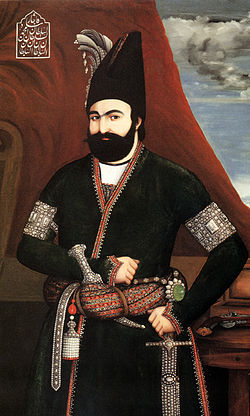- Mohammad Shah Qajar
-
 Mohammad Shah Qajar
Mohammad Shah QajarShahanshah of Persia 
Reign 1834-1848 Full Name Mohammad Shah Qajar Born 5 January 1808 Birthplace Tabriz, Persia Died 5 October 1848 (aged 40) Place of death Tehran, Persia Predecessor Fat′h-Ali Shah Qajar Successor Naser al-Din Shah Dynasty Qajar Dynasty Religious beliefs Shia Islam Mohammad Shah Qajar (born Mohammad Mirza, Persian: محمد شاه قاجار) (January 5, 1808 - September 5, 1848) was king of Persia from the Qajar dynasty (23 October 1834 - 5 September 1848).
Contents
Rise to power
Mohammad Shah was son of Abbas Mirza, the crown prince and governor of Azerbaijan,[1] who in turn was the son of Fat′h Ali Shah Qajar, the second Shah of the dynasty. At first, Abbas Mirza was the chosen heir to the Shah. However, after he died, the Shah chose Mohammad to be his heir. After the Shah's death, Ali Mirza, one of his many sons, tried to take the throne in opposition to Mohammad. His rule lasted for about 40 days. Nonetheless, he was quickly deposed at the hands of Mirza Abolghasem Ghaem Magham Farahani, a politician, scientist, and poet.
Reign
Politics and the military
Ali was forgiven by Mohammad, who had then become Shah. Farahani was awarded the position of chancellorship of Persia by Shah at the time of his inauguration. He was later betrayed and executed by the order of Shah in 1835, at the instigation of Hajj Mirza Aghasi, who would become the Ghaem Magham's successor and who greatly influenced Shah's policies. One of his wives, Malek Jahan Khanom, Mahd-e Olia, later became a large influence on his successor, who was their son.[2]
He also tried to capture Herat, which was then owned by the British, twice. To try to defeat the British, he sent an officer to the court of Louis-Philippe of France. In 1839, two French military instructors arrived at Tabriz to aid him. However, both attempts to capture the city were unsuccessful.[3][4]
Shah was known to be somewhat sickly throughout his life, and he finally died at the age of 40 of gout.
Cultural trends
Shah fell into the influence of Russia and attempted to make reforms to modernize and increase contact with the West. This work was continued by his successor, Nasser-al-Din Shah Qajar, who became known as a very capable leader.[5] These efforts to modernize the country brought about a great interest in photography.[6] Other artwork during this time includes a number of small-scale paintings on lacquer.[7]
During Shah's reign, the religious movement of Bábism began to flourish for the first time. The Persian symbol of The Lion and Sun and a red, white, and green background became the flag at this time.[8]
Children
During his reign, Shah had 11 children to eight wives, and four more wives with whom he had no children. Seven of his children died in infancy, but among the more notable of the children were:
- Prince Nasser al-Din Mirza, later Nasser-al-Din Shah Qajar (July 16, 1831 - May 1, 1896)
- Prince Abbas Mirza Molk Ara (November 27, 1839 - April 14, 1897) ancestor of Shams Molk Ara family
- Prince Mohammad Taqi Mirza Rokn ed-Dowleh (1840–1901)
- Prince Abdol-samad Mirza Ezz ed-Dowleh Saloor (May 1843–1929) ancestor of the Salour family (http://en.wikipedia.org/wiki/Abdol-samad_Mirza_Ezz_ed-Dowleh_Saloor)
Honours
(all received in 1834)
- Knight of the Order of St. Andrew of Russia
- Knight of the Order of St. Alexander Nevsky of Russia
- Knight of the Order of Saint Stanislaus of Russia
- Knight of the Order of the White Eagle of Russia
- Knight of the Order of St Anne, 1st Class of Russia
See also
References
External links
- The Qajar Dynasty (Rokni, Shams-ol-Molk Arai) Genealogy, [1]
- Photos of qajar kings
Mohammad Shah QajarBorn: 5 January 1808 Died: 5 September 1848Regnal titles Preceded by
Fat′h Ali Shah QajarShah of Persia
1834-1848Succeeded by
Nasser-al-Din Shah QajarCategories:- Qajar dynasty
- Qajar shahs
- Monarchs of Persia
- 1808 births
- 1848 deaths
- Order of St. Alexander Nevsky recipients
- Recipients of the Order of the White Eagle (Russian)
- Recipients of the Order of St. Andrew
Wikimedia Foundation. 2010.
